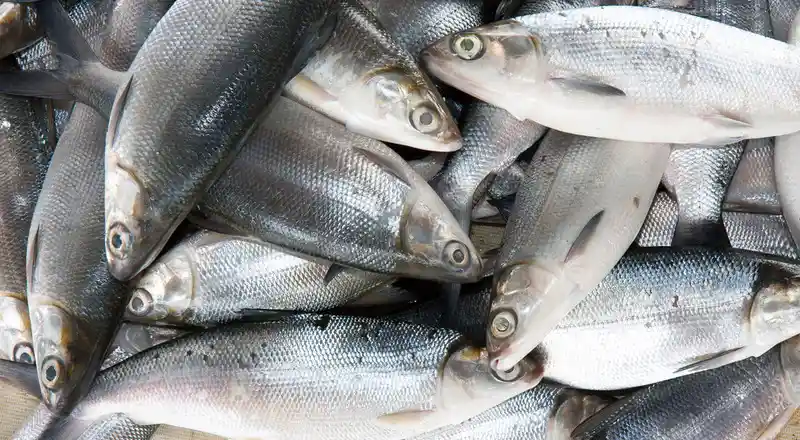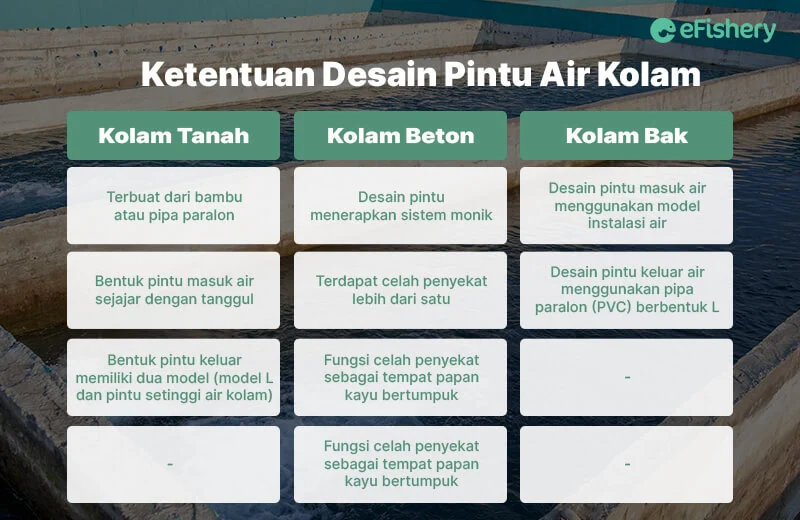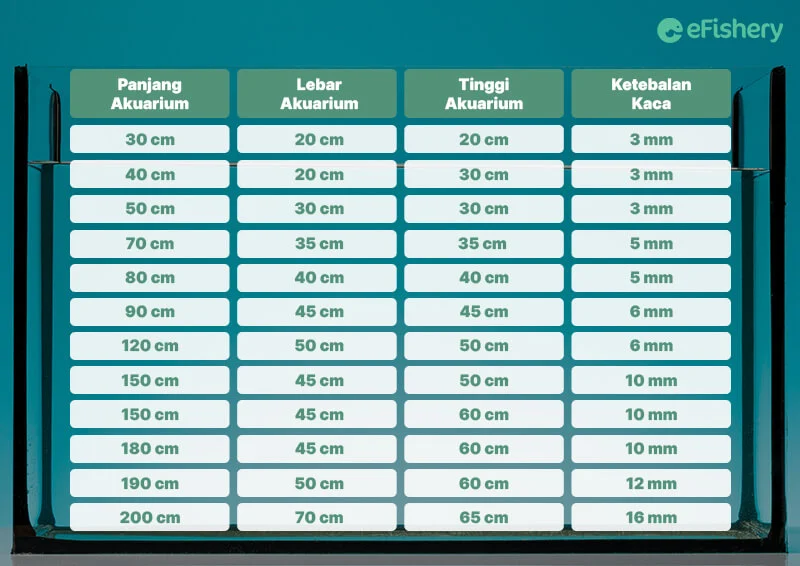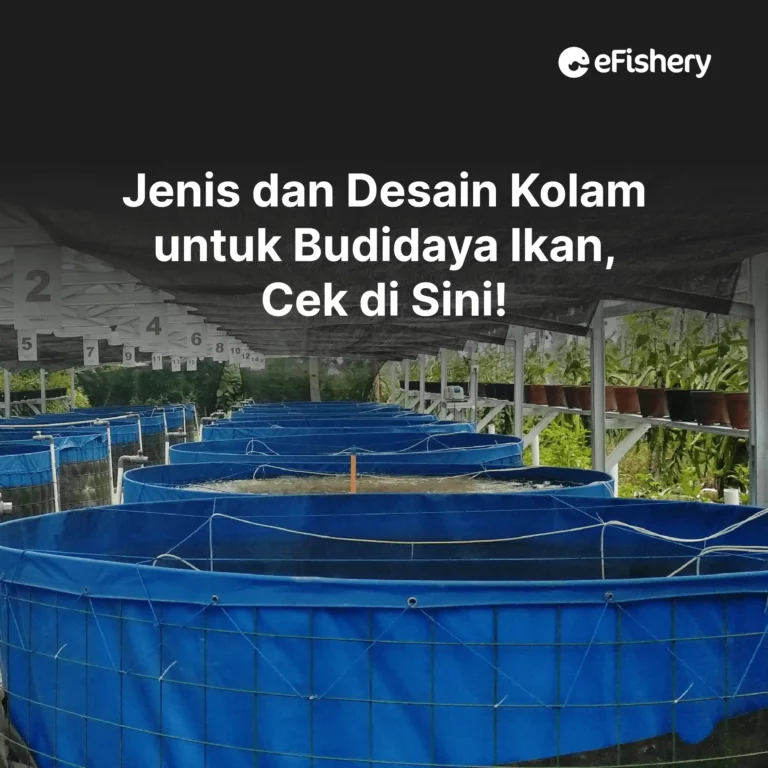Ponds have an important role for the success of fish farming, especially during the process of hatching and rearing fish. Therefore, cultivators need to pay close attention to the design of fish farming ponds. Based on the cultivation system, the types of fish ponds are divided into 3 types, namely traditional or extensive ponds, semi-intensive ponds and intensive ponds.
Traditional ponds are fish farming ponds where the entire material for making them uses soil. While the semi-intensive pool is a pool whose walls are made of concrete or walls and the bottom is made of soil. The last type is an intensive pool made of concrete walls as a whole, starting from the boundary, the walls, to the bottom of the pool.
In addition, cultivators need to pay attention to the design construction of aquaculture ponds and important factors when constructing ponds. In this article, eFishery will discuss thoroughly the factors that you need to pay attention to when building a pond as well as the construction of any fish farming pond designs to choose from. Let's listen!
Fish Farming Pond Design Factors

To help the fish enlargement process, as cultivators we need to prepare the best possible fish pond design. There are fundamental factors that you must pay attention to, for example choosing a location, the shape of the pond, to the material for which it is made so that the pool remains sturdy, able to hold large volumes of water and does not leak easily.
The following are the fundamental factors that you should pay attention to.
1. Pond Bunds Design
The role of the pond bunds in the pond system as a whole is to retain the mass of water so that it does not easily escape from the pond. Generally, pond bunds are made of a special type of soil that has water-resistant and leak-resistant properties.
The type of soil that you can use to make pond bunds is ordinary clay or sandy clay. The characteristics of the soil itself must be complete, not easily broken, not easily porous, and have the ability to withstand large amounts of water discharge.
The height of the pond bund can be adjusted according to the height of the pool or the depth of the pool water. Ideally the bunds can reach a size of 20 cm from the bottom surface of the pond. There are two forms of pond bund designs, namely isosceles trapezoidal bunds and isosceles trapezoidal bunds.
2. Basic Design and Pool Channels
There are two types of pool channels, namely the perimeter channel or caren and the middle channel or kemalir. Both of these types of channels are designed to be slanted towards the drain door to make it easier for Cultivator when draining the pond or when going to harvest fish.
Meanwhile, the bottom of the pond has a slope of between 1%-2% for every hundred meters of the bottom length of the pond so that there is a height ratio of 1-2 meters. How to measure it by using a small hose.
The water entrance and water exit are stored in a piece of wood or bamboo. Then, you can stretch a small hose filled with water between the bamboo or wooden meters. The difference in the height of the water between the two ends of the hose is the difference in the height of the ground or the slope of the pond bottom.
3. Pool Sluice Design
The last fundamental factor is the pond sluice design. The pond sluice design itself is divided into two, namely the door for water entering and the door for water leaving. You can make a door in the middle of the shortest pool to facilitate the circulation of water changes. There are also those who design the sluice to be at a diagonal angle.
However, this diagonal door design has a drawback, which is to extend the size of the drying channel, making it quite difficult for Cultivators to harvest fish. There are separate provisions for designing a pool sluice based on the types of pools that you will use.

Fish Farming Pond Construction
The construction of the aquaculture pond is a specific plan or description regarding the arrangement or layout of the media that you will use for fish farming.
The form of the construction itself follows the design of the fish farming pond that the cultivator chooses. For example, the design of an aquarium pond will be different from the design of cages or tub designs. The following is a more detailed description for each cultivation medium.
1. Pond Design Construction
Pond design is the most common type of cultivation media design used for fish farming. The shape of the pool varies, some are rectangular, trapezoidal, triangular, circular, to irregular shapes.
To choose the shape of the pond design, you must consider the land area and cultivation location. Most Cultivators used rectangular ponds.
Pond design construction needs to pay attention to several things, including:
- For preparing ponds, use clay as a material for making pond bunds because it is sticky, water-resistant, not easy to leak, break and pivot, and is able to withstand water discharge.
- The bottom of the pond, the basic construction of the pond is made slightly inclined towards the water outlet.
- The water channel has a perimeter (ceren) and middle (kamalir) construction with a slope level towards the water outlet.
- The sluice has two types of doors, namely the entrance and exit of the water which are designed separately.
2. Tub Design Construction
Generally, cultivators will use tarpaulin or plastic tubs as construction material for cultivation media in the form of tubs. The advantage of this construction is that it does not really require a large enough area of land and is effective for raising consumption fish.
Some fundamental factors that you need to pay attention to include:
- Types of fish to be farmed.
- Cultivation process, including seeding and enlargement processes.
- Alignment between the discharge or volume of water and the tub construction supports.
- Pond bottom construction must be flat to avoid leaks.
- The size of the tub adjusts the land area.
- Water circulation and distribution.
- Production waste production construction.
- Construction of lines for harvesting fish.
3. Aquarium Design Construction
Almost the same as pond design construction, aquarium designs have several shapes, including rectangles, rectangles, trapezoids, ellipses, bottles, hexagons, and octagons. A fundamental factor in aquarium construction is the thickness of the glass.
Ideally, the thickness of the glass that you use is between 3-16 mm. Then, from the initial size, you need to add another 1-2 mm in thickness.
Thick or thin aquarium glass depends on the size of the aquarium. The larger the size of the aquarium, the thicker the glass you will use.
The following table shows the relationship between the size of the aquarium and the thickness of the glass.

4. Construction of floating net or floating net cage designs
The design of fish farming ponds for floating net cages or floating nets has two construction frameworks, namely the frame and the net bag. The function of the frame construction is to install the net bag and as a place for feeding and harvesting fish. As for the net bag itself, its function is to keep fish.
The material for making floating nets is bamboo. The fundamental factors that you must pay attention to when constructing floating net cages or the floating nets themselves include:
- Avoid using water currents that are too strong. The function of the water current is to facilitate oxygen circulation and water exchange. In addition, this water current also serves to wash away the remaining feed and fish waste.
- Use water that has a low to moderate fertility rate to maintain the oxygen content in the water.
- Pay attention to the construction of the largest pond from any form of pollution that can affect water quality.
- Maintain water quality to support fish growth.
- Pay attention to the construction arrangement of floating net cages which consists of a frame, buoys, ties, anchors, net bags, weights, nylon ropes and ropes.
Kembangkan Bisnis Budidaya Ikan Pakai Kabayan!
Mengembangkan bisnis budidaya ikan bisa Bapak/Ibu lakukan dengan menggunakan Kabayan (Love, Pay Later) yang menyediakan akses ke institusi finansial terpercaya serta diawasi/berizin OJK. Bapak/Ibu bisa mendapatkan pakan berkualitas dengan sistem pembayaran tempo yang dapat dibayarkan setelah panen. Dengan proses cepat dan persyaratan mudah, budidaya ikan pun makin lancar pakai Kabayan.
Isi formulir berikut untuk mendapatkan akses ke Kabayan!
Get Access to Financial Institutions that are Trusted, Registered & Supervised by OJK!
Fill in your personal data in the following form. Our team will immediately contact you via the number cellphone attached. Make sure the data entered is correct.
Questions Regarding the Design of Fish Farming Ponds
Technically, there are several factors that cultivators must pay attention to when building a cultivation pond, including the design of the pond bunds, the design of the pond bottom and channel, and the design of the pond sluice.
The design and construction of fish ponds depends on the type of media used by the cultivator. There are 4 construction design options, including pond design construction, tub design construction, aquarium construction, and floating net cage design construction.
- https://www.mikirbae.com/2015/06/desain-dan-kontruksi-wadah.html
- https://www.awalilmu.com/2016/02/jenis-jenis-kolam-budidaya-ikan-dan-desainnya.html
- https://sumateranews.co.id/konstruksi-dan-pembuatan-kolam-untuk-budidaya-ikan/
- https://berita.99.co/desain-kolam-terpal-budidaya-ikan/
- https://artikel.rumah123.com/desain-kolam-terpal-untuk-budidaya-ikan
